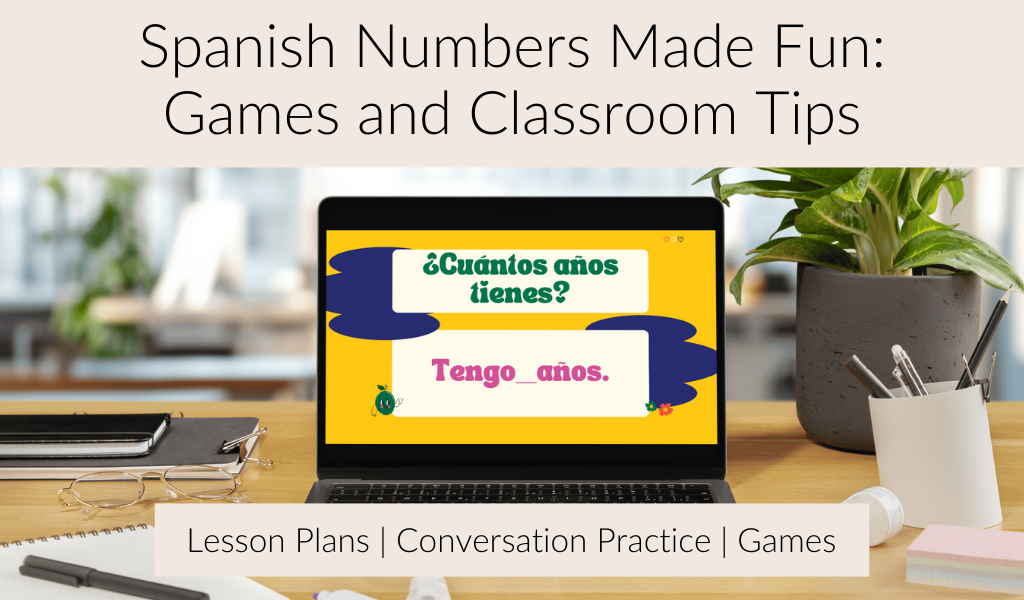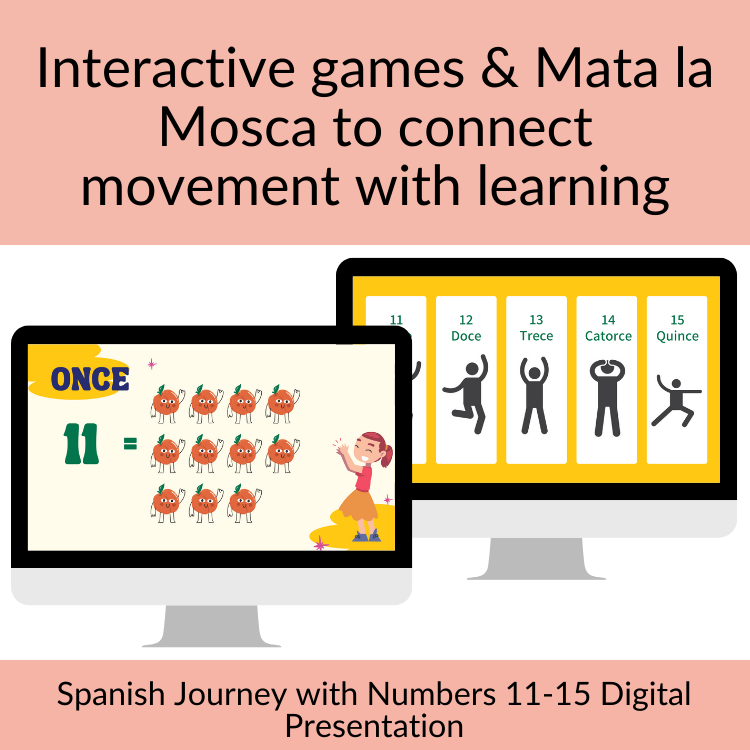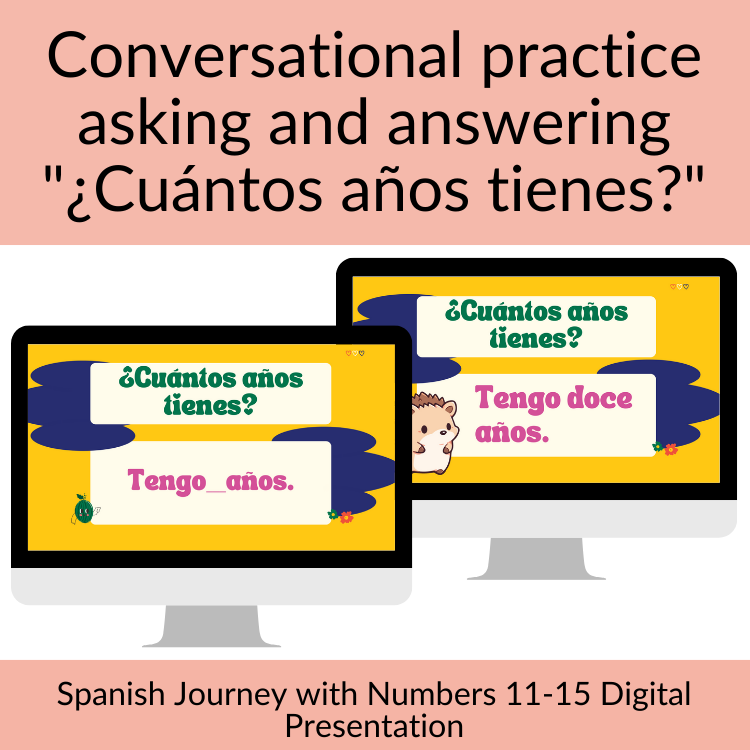Your Spanish Journey with Los Números 11-15 digital presentation is an engaging, interactive way to introduce and reinforce Spanish numbers in your classroom. But what makes this resource even more powerful is its versatility. Today, I’ll share how you can use this presentation for whole-class, small group, partner, and independent work, and I’ll introduce some new games to keep the learning fun and dynamic. Plus, I’ll explain the neuroscience behind why blending these types of activities enhances student learning—and provide five classroom management tips to ensure everything runs smoothly.
The Neuroscience and Pedagogy Behind Blending Different Learning Formats
Blending whole-class instruction, small group collaboration, partner work, and independent activities is not only engaging but also supports multiple aspects of brain development. According to research on multimodal learning, engaging different parts of the brain by mixing visual, auditory, and kinesthetic activities boosts memory retention and helps students process information in deeper, more meaningful ways.
- Whole-Class Instruction: Allows for clear modeling and input, essential for auditory and visual learners.
- Small Groups and Partners: Activate social learning, helping students practice language in a supportive setting where peer feedback can accelerate language acquisition.
- Independent Work: Reinforces personal accountability and allows students to process at their own pace, helping to consolidate learning.
The brain thrives on variety, and by switching between these formats, you stimulate different parts of the brain, making learning stick!
How to Use the Presentation for Whole Class, Small Group, Partner, and Independent Work
- Whole-Class Instruction: Use the Spanish Journey with Los Números 11-15 digital presentation to introduce or review numbers 11-15 in a large group setting. As a teacher, you can:
- Present each number with pronunciation and written form on the screen.
- Have the class repeat after you, practicing pronunciation together.
- Call out a number and have students do that many jumping jacks, bicep curls, squats, or calf raises while counting out loud as a class.
- Small Group Activities: After the initial presentation, divide students into small groups for deeper practice.
- Have groups work on different slides or tasks. For example, Group A might focus on recognizing numbers, Group B on pronunciation, and Group C on using numbers in phrases.
- Use a “Number Relay” where each group is given a set of numbered flashcards (11-15). They must work together to order the numbers correctly and say the full sentence (“Tengo doce años”) before moving on to the next round.
- Incorporate hands-on activities like having groups build sentences using word or number cards.
- Partner Work: Students can pair up for interactive speaking practice, encouraging both language production and peer learning.
- One partner can act as the “birthday person,” saying “Tengo ___ años,” while the other guesses which number they said, using visuals from the presentation as clues.
- Another great partner activity is “Memory Match”: Create pairs of cards—one with the number (11, 12, etc.) and one with the matching phrase (Tengo doce años). Partners take turns flipping cards, trying to find the matching pairs while saying the number out loud.
- Independent Work: For individual reinforcement, use the independent tracing and writing activities from the presentation or worksheets.
- Have students work on their own to trace and write numbers 11-15, then complete sentences like “Tengo once años” based on their own age.
- Allow them to explore the digital presentation at their own pace, building their confidence as they progress.
- Encourage them to record themselves saying each number and phrase as a speaking assessment.
Get Your Resource: Spanish Journey with Numbers 11-15 Digital Presentation
5 Fun Games to Compliment the Presentation
- Número de Salto (Number Jump)
Set up number stations (11-15) around the room. Call out a number in Spanish, and students must jump to that number station and say the corresponding phrase (“Tengo trece años!”) out loud. - Carrera de Frases (Phrase Race)
Divide the class into two teams. Each team must race to complete a series of sentence-building challenges (like assembling the sentence “Tengo once años” using flashcards) before the other team. - Pasa la Frase (Pass the Phrase)
In a large circle, students pass a ball. Each student who receives the ball must say a phrase using one of the numbers (“Tengo quince años”). Add variations by making the next student say a number that is one more or one less. - Ritmo y Números (Rhythm and Numbers)
Have students clap, snap, or use rhythm instruments while they recite the numbers. It’s a great way to combine movement with repetition for auditory and kinesthetic learners. - Lotería (Bingo)
A simple but effective game! Give students bingo cards with numbers 11-15. As you call out each number in Spanish, they must find the matching number on their card and say “Tengo __ años” before marking it. The first to complete a row wins.
5 Classroom Management Tips for All Activity Types
- Clear Instructions:
Before transitioning to any activity, ensure you give clear, step-by-step instructions. Demonstrate the activity first with a few students to model expectations. - Use Signals:
For whole-class and small-group activities, use non-verbal signals to grab attention (e.g., clapping patterns or raised hands). This helps you manage noise and transitions smoothly. - Flexible Grouping:
Rotate groups regularly so students can work with different classmates. This prevents cliques and allows for a diversity of learning experiences. - Visual Timers:
Use a timer for both small group and independent work. Visual timers help keep students on task and give them a clear expectation of how long they have to complete an activity. - Positive Reinforcement:
Whether students are working independently or in a group, positive reinforcement keeps the energy up. Use praise for both effort and accuracy—especially when students are practicing speaking in Spanish. For example, “¡Excelente trabajo diciendo ‘Tengo doce años!’”
The Gist of it All
Your Spanish Journey with Los Números 11-15 digital presentation is more than just a lesson—it’s an interactive experience. By blending whole-class instruction, small group activities, partner work, and independent tasks, you’re engaging your students’ brains in multiple ways. This combination boosts retention, supports language acquisition, and keeps learning fun and dynamic. Use the new games and strategies outlined here, and watch your students’ confidence soar as they master numbers 11-15.
If you’re looking for a complete unit on numbers 1-20 plus phrases like ¿Cuántos hay? And ¿Cuántos años tienes? Check out the full Spanish Journey with Los Números set!
Spanish Journey with Los Números 1-5 Digital Presentation
Spanish Journey with Los Números 1-5 Independent Activity Packet
Spanish Journey with Numbers 6-10 Digital Presentation
Spanish Journey with Los Números 6-10 Independent Activity Packet
Spanish Journey with Numbers 11-15 Digital Presentation
Spanish Journey with Números 11-15 Independent Activity Packet
Spanish Journey with Numbers 16-20 Digital Presentation
Spanish Interactive Counting & Tracing Numbers 0-20: A Complete Resource

Resources
Medina, J. (2014). Brain Rules: 12 Principles for Surviving and Thriving ata Work, Home, and School.
Willis, J. (2011). The Neuroscience of Joyful Education.
Jensen, E. (2005). Teaching with the Brain in Mind.




